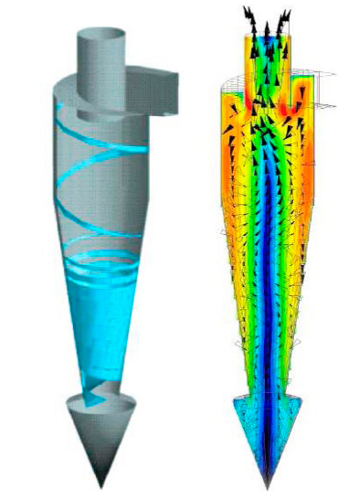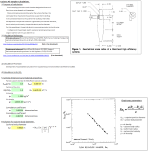Cyclone air sampler 1.2 XLC.xlsx

Description
Purpose of calculation
An air sampling cyclone is a small chamber designed to force an airflow into a vortex-shaped, swirling pattern. When entrained aerosol particles enter the cyclone chamber, the centripetal force imparted to the particles causes them to be flung in an outwards direction to the cyclone inner surfaces, where they are deposited. The particle collection is governed by the chamber diameter, the air velocity and viscosity, the particle density and its diameter. For this spreadsheet, the particle density is assumed equivalent to that of water. In reference to the enclosed sketch, typical air sampling cyclones could range in size from 2.5 mm up to 150 mm I.D.
Calculation Reference. Design of Stairmand-type sampling cyclones. Am Ind Hyg Assoc J, 51(3), 151-159.
Calculation Reference
Fluid and Particulate Mechanics
Design of Cyclone Dust Collectors
Ambient Air Quality Standards
The design of Stairmand-type sampling cyclones involves several considerations, as outlined in the paper 'Design of Stairmand-type sampling cyclones' by Marple et al. (1990) in the American Industrial Hygiene Association Journal. The Stairmand-type cyclone is a type of inertial particle separator that is commonly used for sampling airborne particulate matter.
The design process involves the following steps:
-
Determine the sampling objective: The first step is to determine the specific objectives of the sampling, such as the particle size range of interest and the sampling flow rate.
-
Select the appropriate cyclone: The Stairmand-type cyclone is a family of cyclones with different dimensions, flow rates, and collection efficiencies. The appropriate cyclone is selected based on the sampling objective and the properties of the particles being sampled.
-
Determine the cyclone dimensions: The dimensions of the cyclone, such as the inlet diameter, body diameter, and length, are determined based on the sampling flow rate, the desired cut-off diameter, and the separation efficiency.
-
Calculate the pressure drop: The pressure drop across the cyclone is calculated based on the dimensions, the sampling flow rate, and the particle properties.
-
Test the cyclone performance: The cyclone is tested using standard procedures to determine its collection efficiency and cut-off diameter for the target particle size range.
-
Evaluate the cyclone performance: The performance of the cyclone is evaluated based on its collection efficiency, cut-off diameter, pressure drop, and other factors.
-
Optimize the cyclone design: The design is optimized to achieve the desired performance while minimizing the pressure drop and other factors.
The Stairmand-type cyclone is widely used for sampling airborne particulate matter in various industries, including environmental monitoring, occupational health and safety, and process control. The design process outlined in the paper provides a systematic approach to designing cyclones that meet specific sampling objectives and performance requirements.
Calculation Preview
Full download access to any calculation is available to users with a paid or awarded subscription (XLC Pro).
Subscriptions are free to contributors to the site, alternatively they can be purchased.
Click here for information on subscriptions.


